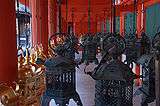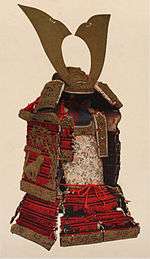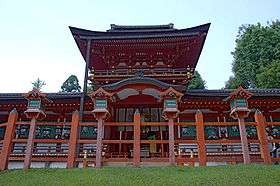Kasuga-taisha
| Kasuga-taisha 春日大社 | |
|---|---|
|
The middle gate and hall | |
| Information | |
| Type |
Twenty-Two Shrines Chokusaisha Beppyo jinja, Shikinaisya Former kanpeitaisha |
| Dedicated to |
Takemikazuchi-o Futsunushi Ame no Koyane Himegami |
| Founded | 768 |
| Reisai |
Kasuga-no-matsuri (Kasuga-sai: 春日祭) (13th March) |
| Honden style | Kasuga-zukuri |
| Address | 160 Kasugano-chō, Nara-shi, Nara-ken |
| Website |
www |
|
| |
Kasuga Grand Shrine (春日大社 Kasuga-taisha) is a Shinto shrine in the city of Nara, in Nara Prefecture, Japan.[1] Established in 768 AD and rebuilt several times over the centuries, it is the shrine of the Fujiwara family. The interior is famous for its many bronze lanterns, as well as the many stone lanterns that lead up the shrine.
The architectural style Kasuga-zukuri takes its name from Kasuga Shrine's honden (sanctuary).
Kasuga Shrine, and the Kasugayama Primeval Forest near it, are registered as a UNESCO World Heritage Site as part of the "Historic Monuments of Ancient Nara".
The path to Kasuga Shrine passes through Deer Park. In Deer Park, deer are able to roam freely and are believed to be sacred messengers of the Shinto gods that inhabit the shrine and surrounding mountainous terrain. Kasuga Shrine and the deer have been featured in several paintings and works of art of the Nambokucho Period.[2] Over three thousand stone lanterns line the way. The Man'yo Botanical Garden, Nara is adjacent to the shrine.
History
The shrine became the object of Imperial patronage during the early Heian period.[3] In 965, Emperor Murakami ordered that Imperial messengers were sent to report important events to the guardian kami of Japan. These heihaku were initially presented to 16 shrines including the Kasuga Shrine.[4]
From 1871 through 1946, Kasuga Shrine was officially designated one of the Kanpei-taisha (官幣大社), meaning that it stood in the first rank of government supported shrines.[5]
Festivals
During the festivals of Setsubun Mantoro (February 2–4) and Obon Mantoro (August 14–15), the thousands shrine lanterns of Kasuga-taisha are all lit at once.[6]
March 13 is the Kasuga Matsuri ("Monkey Festival"), which features gagaku and bugaku dance performances.[6]
Kasugayama Primeval Forest
Kasugayama Primeval Forest is primeval forest of about 250ha near the summit of Kasugayama (498m), and contains 175 kinds of trees, 60 bird types, and 1,180 species of insects. In this area adjacent to Kasuga Grand Shrine, hunting and logging have been prohibited since AD 841. Because Kasugayama has long been tied to Kasuga Grand Shrine worship, it is regarded as a sacred hill. The forest backdrop of the Kasuga Grand Shrine's buildings today has been unchanged since the Nara period.[7][8]
Images
 Chakutoden
Chakutoden Kurumayadori
Kurumayadori Minamimon
Minamimon Sakadono
Sakadono Heiden, Buden
Heiden, Buden Keishoden
Keishoden A smaller enclave
A smaller enclave Lanterns
Lanterns- Corridors in the shrine complex
 Lanterns
Lanterns Bronze lanterns
Bronze lanterns Stone lantern leading up to shrine framing a Nara Park deer
Stone lantern leading up to shrine framing a Nara Park deer Tying Omikuji at Kasuga Shrine
Tying Omikuji at Kasuga Shrine- Path leading up to the shrine, braced by rows of stone lanterns
- Kasuga stone lantern presented in 1997 to Nara sister city, Canberra, Australian Capital Territory
 A "breast shrine" at the Kasuga Shrine walk decked with Ema plaques
A "breast shrine" at the Kasuga Shrine walk decked with Ema plaques Armour laced with red threads With bamboo, tiger, sparrow motif; nomination includes the helmet; said to have been dedicated by Minamoto no Yoshitsune; one of two similar armours at Kasuga-taisha 1185 Kamakura period Ō-yoroi
Armour laced with red threads With bamboo, tiger, sparrow motif; nomination includes the helmet; said to have been dedicated by Minamoto no Yoshitsune; one of two similar armours at Kasuga-taisha 1185 Kamakura period Ō-yoroi Hanging lanterns and Andons in the Setsubun Mantoro Festival
Hanging lanterns and Andons in the Setsubun Mantoro Festival Hanging lanterns and Andons in the Setsubun Mantoro Festival. Andons, there are special prayers to the reconstruction and walfare for the victims of the Great East Japan earthquake and the 2011 flood disaster.
Hanging lanterns and Andons in the Setsubun Mantoro Festival. Andons, there are special prayers to the reconstruction and walfare for the victims of the Great East Japan earthquake and the 2011 flood disaster. Hanging lantern designed a drooping wisteria in the Setsubun Mantoro Festival
Hanging lantern designed a drooping wisteria in the Setsubun Mantoro Festival "Sunazuri-no-Fuji", wisteria flowers drooping down to reach the sand on the ground
"Sunazuri-no-Fuji", wisteria flowers drooping down to reach the sand on the ground
See also
- List of Shinto shrines
- Twenty-Two Shrines
- List of National Treasures of Japan (crafts-others)
- List of National Treasures of Japan (crafts-swords)
- List of National Treasures of Japan (shrines)
- Deer (mythology)
- Modern system of ranked Shinto Shrines
- Kasuga Maru
- List of Special Places of Scenic Beauty, Special Historic Sites and Special Natural Monuments
Notes
- ↑ Richard, Ponsonby-Fane. (1964) Visiting Famous Shrines in Japan, pp. 221-251.
- ↑ Birmingham Museum of Art (2010). Birmingham Museum of Art : guide to the collection. [Birmingham, Ala]: Birmingham Museum of Art. p. 46. ISBN 978-1-904832-77-5.
- ↑ Breen, John et al. (2000). Shinto in History: Ways of the Kami, pp. 74-75.
- ↑ Ponsonby-Fane, Richard. (1962). Studies in Shinto and Shrines, pp. 116-117.
- ↑ Ponsonby-Fane, Richard. (1959). The Imperial House of Japan, pp. 124.
- 1 2 "Kasuga Taisha". Hattori Foundation (est.1919) - The Yamasa Institute. Retrieved March 12, 2010.
- ↑ Naracity Tourist Association
- ↑ Japan Airline "Guide to Japan - Historic Monuments of Ancient Nara"
References
- Breen, John and Mark Teeuwen. (2000). Shinto in History: Ways of the Kami. Honolulu: University of Hawaii Press. ISBN 978-0-8248-2363-4
- Ponsonby-Fane, Richard. (1962). Studies in Shinto and Shrines. Kyoto: Ponsonby Memorial Society. OCLC 399449
- ____________. (1959). The Imperial House of Japan. Kyoto: Ponsonby Memorial Society. OCLC 194887
- ____________. (1964). Visiting Famous Shrines in Japan. Kyoto: Ponsonby-Fane Memorial Society. OCLC 1030156
External links
| Wikimedia Commons has media related to Kasuga-taisha. |
- Official site in Japanese
- Japan Guide
- New York Public Library Digital Gallery, early photograph of entrance to Kasuga Shrine
- National Diet Library: photo, 1913
- National Archives of Japan: Kasugashinkozu, scroll showing annual festival at Nara Kasuga Grand Shrine (Edo period)
Coordinates: 34°40′53″N 135°50′54″E / 34.68139°N 135.84833°E
